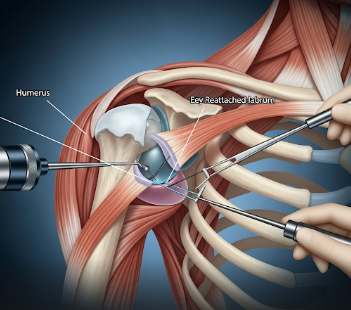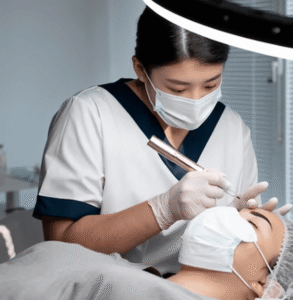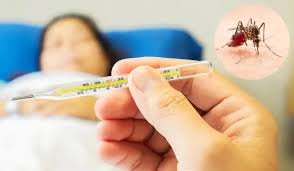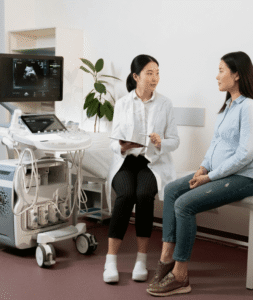Overview
Shoulder stabilisation surgery is a procedure designed to restore stability to a shoulder joint that frequently dislocates or is prone to instability. It is commonly recommended for patients with recurrent shoulder dislocations, ligament injuries, or structural damage to the shoulder socket (glenoid) or labrum.
In Korea, shoulder stabilisation surgery is offered in advanced orthopedic and sports medicine centers, combining arthroscopic and open techniques, minimally invasive procedures, and expert post-operative rehabilitation. Patients worldwide choose Korea for this surgery due to high success rates, low recurrence of dislocation, and fast recovery protocols.
What is Shoulder Stabilisation Surgery?
Shoulder stabilisation surgery aims to repair torn ligaments, labrum, or other supporting structures to prevent repeated dislocations and restore normal shoulder function.
Types of surgery include:
- ✦ Arthroscopic Bankart repair – minimally invasive repair of torn labrum.
- ➤ Open shoulder stabilization – larger incision for severe or complex cases.
- ✦ Latarjet procedure – transfers bone from the coracoid to strengthen the shoulder socket in cases of bone loss.
- ➤ Capsular shift or plication – tightens overstretched ligaments to improve stability.
The choice of procedure depends on age, activity level, severity of instability, and bone structure.
What are the Benefits?
Shoulder stabilisation surgery provides several advantages:
✅ Prevents recurrent dislocations – stabilizes the shoulder joint.
➤ Improves shoulder function – restores range of motion and strength.
✦ Reduces pain – especially during activity or sports.
➤ Minimally invasive options – smaller incisions and faster recovery.
✅ Enables return to sports or physically demanding jobs.
✦ Long-term joint preservation – prevents further cartilage or bone damage.
Procedure Details
1) How should I prepare for Shoulder Stabilisation Surgery?
Preparation includes:
- ✦ Medical evaluation – X-rays, MRI, or CT scans to assess labrum, ligaments, and bone.
- ➤ Medication review – stop blood thinners or anti-inflammatory drugs if advised.
- ✦ Pre-operative physiotherapy – may improve muscle strength and post-op recovery.
- ➤ Discussion with surgeon – procedure type, expected outcomes, risks, and recovery plan.
- ✦ Fasting – typically 6–8 hours before surgery.
- ➤ Anesthesia assessment – general anesthesia is commonly used.
2) What happens during the procedure Shoulder Stabilisation Surgery?
The surgery is usually performed under general anesthesia and takes 1–2 hours depending on complexity:
➤ Step 1: Patient is positioned and the surgical area is sterilized.
✦ Step 2: Small arthroscopic incisions are made (or open incision for complex cases).
➤ Step 3: Torn ligaments, labrum, or capsule are repaired using sutures, anchors, or bone grafts as needed.
✦ Step 4: For Latarjet, bone is transferred and secured to strengthen the socket.
➤ Step 5: Incisions are closed, and a sterile dressing or shoulder immobilizer is applied.
Arthroscopic techniques allow precise repair with less tissue damage and faster recovery.
3) What happens after a Shoulder Stabilisation Surgery?
Post-operative care includes:
- ✦ Hospital stay: typically 1–2 days for observation.
- ➤ Immobilization: shoulder sling for 4–6 weeks to protect repair.
- ✦ Pain management: medications for mild to moderate pain.
- ➤ Gradual physical therapy: passive range of motion progressing to strengthening exercises over 3–6 months.
- ✦ Follow-up visits: to monitor healing, function, and range of motion.
- ➤ Return to sports: usually after 4–6 months, depending on recovery and surgeon assessment.
Most patients experience improved stability and function, with reduced risk of future dislocations.
Risks / Benefits
Potential Risks:
- ✦ Infection at the surgical site.
- ➤ Stiffness or limited range of motion.
- ✦ Nerve injury (rare).
- ➤ Failure of repair or recurrent instability.
- ✦ Pain or swelling post-surgery.
Benefits:
- ✅ Restores shoulder stability and prevents recurrent dislocations.
- ✅ Improves strength and range of motion.
- ✅ Minimally invasive options allow faster recovery.
- ✅ Enables safe return to sports or physically demanding activities.
Recovery and Outlook
Recovery from shoulder stabilisation surgery is gradual but predictable:
- ➤ Hospital stay: 1–2 days.
- ✦ Immobilization: 4–6 weeks.
- ➤ Physiotherapy: begins with passive movements, then active strengthening over 3–6 months.
- ✦ Return to daily activities: typically 6–12 weeks.
- ➤ Return to full sports or heavy lifting: 4–6 months.
- ✦ Long-term outcome: most patients regain stable, functional shoulders with low recurrence of dislocation.
When To Call the Doctor
Patients should contact their healthcare provider if they notice:
⚠ Severe or increasing pain unrelieved by medication.
⚠ Swelling, redness, or pus at the incision site.
⚠ Numbness or tingling in the arm or hand.
⚠ Inability to move the shoulder after the immobilization period.
⚠ Signs of infection or unexpected complications during physical therapy.
Best Korea Option / Process
Korea provides world-class shoulder stabilisation care with:
- ✦ Top orthopedic and sports medicine surgeons specializing in arthroscopic and open shoulder repair.
- ➤ Advanced imaging and surgical tools for precise repair.
- ✦ Minimally invasive arthroscopic procedures for faster recovery and smaller scars.
- ➤ Comprehensive post-operative rehabilitation programs for optimal functional recovery.
- ✦ Affordable and accessible care for international patients.
- ➤ Multidisciplinary teams including anesthesia, nursing, and physiotherapy for smooth recovery.
Korea is an excellent destination for safe, effective, and precise shoulder stabilisation surgery with excellent long-term outcomes.
Highlights of Shoulder Stabilisation Surgery in Korea
- ✅ Restores shoulder stability and prevents recurrent dislocations.
- ➤ Minimally invasive arthroscopic options for faster recovery.
- ✦ Improves strength, range of motion, and shoulder function.
- ➤ Performed by top Korean orthopedic surgeons with expert rehabilitation support.
- ✅ Short hospital stay with comprehensive post-operative care.













